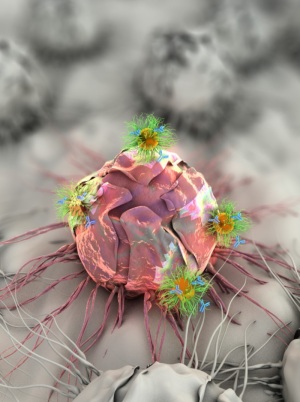Patch can deliver drug, gene and light-based therapy to colorectal tumor sites
by
Christina Hwang, Contributing Reporter | July 29, 2016

May lead to complete eradication
of tumor cells
Credit:Ella Maru
Using a treatment method created by researchers from MIT, patients with colorectal cancer may one day have a patch placed within their body to deliver drug, gene and light-based therapy to the tumor.
The patch, containing gold nanorods, treats not only the tumor but any cells that may still be present after surgery. When radiation is applied to the area, the nanorods heat up and kill the tumor cells, and also release a chemotherapy drug.
The gold nanorods that do not heat up deliver RNA, or gene therapy, to the area to ensure that the oncogenes — the genes that cause healthy cells to turn into tumor cells — are “silenced”.
Releasing this triple-combination therapy locally at the tumor site may increase the efficacy of the treatment, said lead researcher Natalie Artzi, from MIT’s Institute for Medical Engineering and Science, assistant professor of medicine at Brigham and Women’s Hospital.
When researchers tested the treatment on mice, they found that 40 percent of the mice who did not have a patch had the cancer return. But when the patch was applied, the cancer did not return and they were in complete remission.
The researchers hypothesize that a clinician could remove the tumor from a patient and then apply the patch to the inner surface of the colon where it will gradually release the three treatments.
The general treatment for cancer is using systemic, whole-body therapies such as chemotherapy, but these drugs may produce unwanted side effects, and according to the announcement, only a small portion of the drug (0.7 percent in mice) reaches the tumor site.
“This means that we are treating both the source of the cancer and the metastases resulting from the source, in a suboptimal manner,” said Artzi, in a statement. “That is what prompted us to think a little bit differently, to look at how we can leverage advancements in materials science, and in particular nanotechnology, to treat the primary tumor in a local and sustained manner.”
In order to use colonoscopy equipment not just for diagnosis but also to inject the patch into the patient, the researchers plan to test the patch in larger models.
“This administration modality would enable, at least in early-stage cancer patients, the avoidance of open field surgery and colon resection,” said Artzi. “Local application of the triple therapy could thus improve patients’ quality of life and therapeutic outcome.”
|
|
|
You Must Be Logged In To Post A Comment
|
